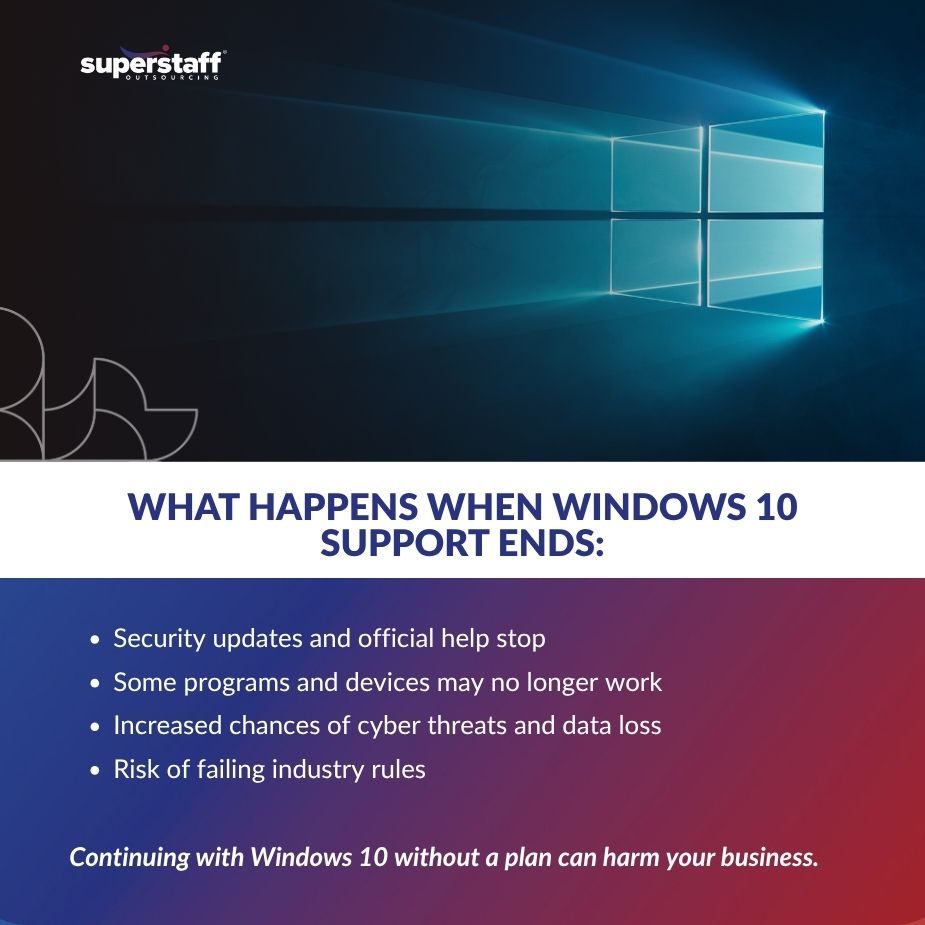
Microsoft will officially end support for Windows 10 in October 2025. This means millions of devices running Windows 10 will no longer receive security updates, bug fixes, or technical help from Microsoft. For many small businesses, this change creates serious challenges. The term windows 10 support ended carries important consequences that every business owner should understand.
Without support, Windows 10 devices become more vulnerable to attacks, software problems, and compliance issues. Many small businesses have not yet planned how to handle this transition. This article explains what the windows 10 support ended means for small businesses, why it matters, and how managed IT support can help your business prepare and stay safe.

What Windows 10 Support Ended Means for Small Businesses
When Windows 10 support ended, it means:
- Microsoft will stop releasing security updates.
- Technical support from Microsoft will no longer be available.
- Software and hardware may stop working correctly with Windows 10.
- Businesses could face higher security risks and compliance problems.
Without regular updates and support, Windows 10 systems become more vulnerable and less reliable for business use. To stay protected and compliant, moving to a supported operating system like Windows 11 is recommended.
1. No More Security Updates
Windows 10 devices will stop getting patches that fix security problems. This increases the chance of viruses, malware, and cyberattacks targeting your systems. These issues could lead to data breaches or loss of important information.
2. Compatibility Issues
New software and hardware might not work properly with Windows 10 after support ends. This could slow down operations or require costly fixes.
3. Compliance Risks
Businesses in regulated industries may fail to meet legal or client requirements if they use unsupported software. This could result in fines or lost contracts.
Because Windows 10 support ended, businesses face real risks. Staying on Windows 10 without a plan is unsafe and could cost more in the long run.
Why Small Businesses Delay IT Upgrades
Despite the risks, many small businesses hesitate to upgrade their systems. Here are some common reasons:
- Budget Constraints: Buying new hardware or software licenses can be expensive. Many small businesses avoid upfront costs.
- Fear of Downtime: Some worry that upgrading will interrupt daily operations or cause data loss.
- Limited IT Staff: Small businesses often have small or no IT teams, making upgrades difficult.
- Uncertainty: Many are unsure what system to switch to or how to manage the upgrade process.
These reasons caused delays that increased the risk after Windows 10 support ended. Waiting too long can make the transition more complex and costly.
How to Prepare for Windows 10 End of Support in 2025
Preparing for the Windows 10 support ended requires planning and expert help. Here are the steps businesses should take:
1. Audit Current Systems
Review all devices and software running Windows 10. Identify what needs upgrading or replacing.
2. Plan the Upgrade
Decide whether to move to Windows 11 or consider alternative operating systems. Evaluate hardware needs and software compatibility.
3. Backup Data
Ensure all important business data is securely backed up before starting the upgrade.
4. Schedule the Transition
Choose a time for the upgrade that minimizes disruption to your business.
5. Test Systems
After upgrading, verify that the software and hardware work correctly.
Taking these steps alone can be complex for small businesses. That is why small businesses need managed IT support for Windows 10 EOL is an important question.
How Managed IT Support Helps Businesses Transition Smoothly
Managed IT support providers specialize in handling upgrades like the Windows 10 end of support. Their services include:
- System Audit and Assessment: Identifying what devices and software need upgrading.
- Upgrade Planning and Execution: Creating a clear, step-by-step plan to move from Windows 10 to Windows 11 or other solutions.
- Data Backup and Migration: Safeguarding data and ensuring nothing is lost during the upgrade.
- Ongoing Monitoring: Watching systems closely after the upgrade to catch and fix issues early.
- Cost Management: Helping control costs with predictable monthly fees and avoiding unexpected expenses.
With managed IT support, businesses avoid downtime and security gaps during the transition. This is why why small businesses need managed IT support for Windows 10 EOL is a key consideration.
Windows 10 Security Risks After End of Support
After Windows 10 support ended, security risks increased. Some of the main risks include:
- Increased Vulnerability to Malware: Unsupported systems are easier targets for hackers.
- No Security Patches: New vulnerabilities discovered will not be fixed.
- Potential Data Breaches: Without updates, sensitive business and customer data could be exposed.
- Compliance Issues: Failure to secure systems may violate data protection laws.
Managed IT providers can reduce these risks by maintaining strong security measures, even after Windows 10 is no longer supported.
Benefits of Managed IT Support Beyond the Upgrade
Managed IT support offers more than just help with upgrading from Windows 10. Long-term benefits include:
- Improved Security: Regular updates and monitoring help protect your business.
- Expert Troubleshooting: Quick response to any technical issues.
- Cost Predictability: Fixed monthly plans make budgeting easier.
- Scalable Support: Services grow as your business grows.
These advantages make managed IT support a valuable investment for maintaining technology and business operations beyond the Windows 10 transition.
Why Act Now as Windows 10 Support Ends
The fact that Windows 10 support ended means small businesses face real risks if they delay action. From security problems to software issues, the challenges are clear.
Managed IT support can help businesses prepare for Windows 10’s end of life, making the upgrade process safe and manageable. It offers ongoing protection and support, reducing risks and simplifying technology decisions.
How to prepare for Windows 10 end of support in 2025 is a question every small business should answer now. Don’t wait until after support ends to find solutions.
If you need help preparing for windows 10 support ended, SuperStaff provides reliable managed IT support designed for small businesses. Contact us today to discuss your upgrade strategy and keep your business secure and up to date.






